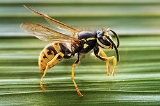
Vespid
Encyclopedia
The Vespidae are a large (nearly 5,000 species), diverse, cosmopolitan family of wasp
s, including nearly all the known eusocial wasps and many solitary wasps. Each social wasp colony
includes a queen and a number of female workers with varying degrees of sterility relative to the queen. In temperate social species, colonies usually only last one year, dying at the onset of winter. New queens and males (drones) are produced towards the end of the summer, and after mating, the queens hibernate over winter in cracks or other sheltered locations. The nests of most species are constructed out of mud, but polistines and vespines use plant fibers, chewed to form a sort of paper
(also true of some stenogastrines). Many species are pollen vectors contributing for the pollination
of several plants, being potential or even effective pollinators .
The subfamilies Polistinae
and Vespinae
are composed solely of eusocial species, while Eumeninae, Euparagiinae, and Masarinae are all solitary; Stenogastrinae
contains a variety of forms from solitary to social.
In Polistinae
and Vespinae
, rather than consuming prey directly, prey are masticated
and fed to the larvae, and the larvae, in return, produce a clear liquid (with high amino acid
content) which the adults consume; the exact amino acid composition varies considerably among species, but it is considered to contribute substantially to adult nutrition.
Wasp
The term wasp is typically defined as any insect of the order Hymenoptera and suborder Apocrita that is neither a bee nor an ant. Almost every pest insect species has at least one wasp species that preys upon it or parasitizes it, making wasps critically important in natural control of their...
s, including nearly all the known eusocial wasps and many solitary wasps. Each social wasp colony
Colony
In politics and history, a colony is a territory under the immediate political control of a state. For colonies in antiquity, city-states would often found their own colonies. Some colonies were historically countries, while others were territories without definite statehood from their inception....
includes a queen and a number of female workers with varying degrees of sterility relative to the queen. In temperate social species, colonies usually only last one year, dying at the onset of winter. New queens and males (drones) are produced towards the end of the summer, and after mating, the queens hibernate over winter in cracks or other sheltered locations. The nests of most species are constructed out of mud, but polistines and vespines use plant fibers, chewed to form a sort of paper
Paper
Paper is a thin material mainly used for writing upon, printing upon, drawing or for packaging. It is produced by pressing together moist fibers, typically cellulose pulp derived from wood, rags or grasses, and drying them into flexible sheets....
(also true of some stenogastrines). Many species are pollen vectors contributing for the pollination
Pollination
Pollination is the process by which pollen is transferred in plants, thereby enabling fertilisation and sexual reproduction. Pollen grains transport the male gametes to where the female gamete are contained within the carpel; in gymnosperms the pollen is directly applied to the ovule itself...
of several plants, being potential or even effective pollinators .
The subfamilies Polistinae
Polistinae
The Polistinae are eusocial wasps closely related to the more familiar yellowjackets, but placed in their own subfamily, containing four tribes; with some 1100 species total, it is the second most diverse subfamily within Vespidae, and while most species are tropical or subtropical, they include...
and Vespinae
Vespinae
The subfamily Vespinae contains the largest and best-known eusocial wasps, including true hornets , and the "yellowjackets" . The remaining genus, Provespa is a small, poorly-known group of nocturnal wasps from Southeast Asia. One genus, Palaeovespa, has been described from the Eocene fossil...
are composed solely of eusocial species, while Eumeninae, Euparagiinae, and Masarinae are all solitary; Stenogastrinae
Stenogastrinae
The Stenogastrinae are a subfamily of Indomalayan and New Guinean Vespid wasps with a diverse biology from solitary to social.The subfamily contains 8 currently recognized genera....
contains a variety of forms from solitary to social.
In Polistinae
Polistinae
The Polistinae are eusocial wasps closely related to the more familiar yellowjackets, but placed in their own subfamily, containing four tribes; with some 1100 species total, it is the second most diverse subfamily within Vespidae, and while most species are tropical or subtropical, they include...
and Vespinae
Vespinae
The subfamily Vespinae contains the largest and best-known eusocial wasps, including true hornets , and the "yellowjackets" . The remaining genus, Provespa is a small, poorly-known group of nocturnal wasps from Southeast Asia. One genus, Palaeovespa, has been described from the Eocene fossil...
, rather than consuming prey directly, prey are masticated
Mastication
Mastication or chewing is the process by which food is crushed and ground by teeth. It is the first step of digestion and it increases the surface area of foods to allow more efficient break down by enzymes. During the mastication process, the food is positioned between the teeth for grinding by...
and fed to the larvae, and the larvae, in return, produce a clear liquid (with high amino acid
Amino acid
Amino acids are molecules containing an amine group, a carboxylic acid group and a side-chain that varies between different amino acids. The key elements of an amino acid are carbon, hydrogen, oxygen, and nitrogen...
content) which the adults consume; the exact amino acid composition varies considerably among species, but it is considered to contribute substantially to adult nutrition.

